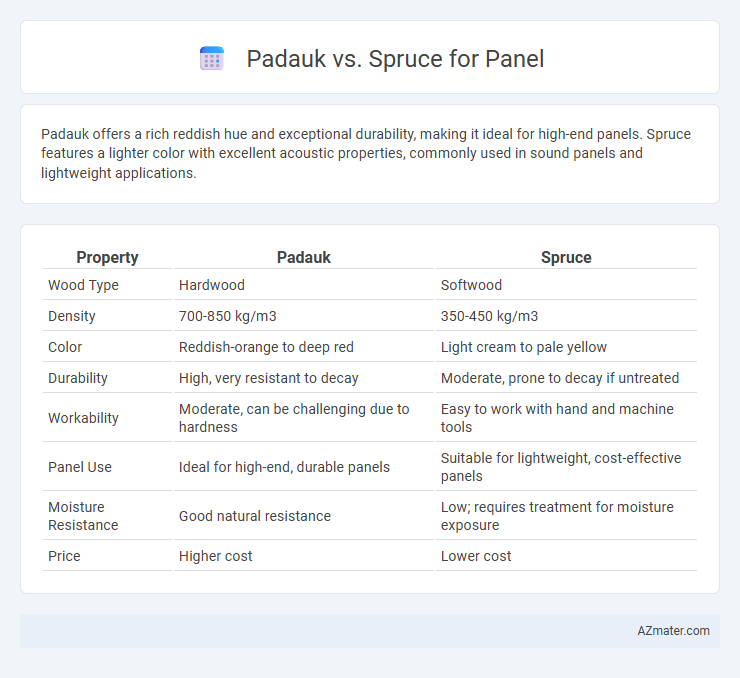Padauk offers a rich reddish hue and exceptional durability, making it ideal for high-end panels. Spruce features a lighter color with excellent acoustic properties, commonly used in sound panels and lightweight applications.
Table of Comparison
| Property | Padauk | Spruce |
|---|---|---|
| Wood Type | Hardwood | Softwood |
| Density | 700-850 kg/m3 | 350-450 kg/m3 |
| Color | Reddish-orange to deep red | Light cream to pale yellow |
| Durability | High, very resistant to decay | Moderate, prone to decay if untreated |
| Workability | Moderate, can be challenging due to hardness | Easy to work with hand and machine tools |
| Panel Use | Ideal for high-end, durable panels | Suitable for lightweight, cost-effective panels |
| Moisture Resistance | Good natural resistance | Low; requires treatment for moisture exposure |
| Price | Higher cost | Lower cost |
Introduction to Padauk and Spruce Woods
Padauk wood, known for its rich reddish-orange hue and natural durability, offers excellent resistance to wear and insects, making it ideal for luxurious paneling. Spruce wood, characterized by its light color and straight grain, provides a lightweight yet strong option favored for its cost-effectiveness and ease of finishing in panel applications. Both woods serve distinct aesthetic and functional roles, with Padauk excelling in visual impact and durability, while Spruce delivers affordability and versatility.
Key Characteristics of Padauk Wood
Padauk wood is prized for its vibrant reddish-orange color that deepens over time, making it highly valued for decorative panels. It offers exceptional durability and resistance to decay, with a dense, fine grain that provides a smooth finish ideal for high-quality interior applications. Compared to spruce, which is lighter and softer with a pale hue, Padauk's strength and rich color enhance the aesthetic and longevity of luxury wood paneling.
Essential Properties of Spruce Wood
Spruce wood is highly valued for its lightweight yet strong structure, making it an ideal choice for paneling that requires durability without excessive weight. Its fine, even texture and pale color provide a smooth surface ideal for painting and finishing, enhancing aesthetic appeal. The wood's excellent acoustic properties and resistance to splitting further contribute to its widespread use in musical instruments and interior panel applications.
Appearance and Aesthetic Differences
Padauk wood features a striking reddish-orange hue that deepens to a rich, warm tone over time, while spruce exhibits a pale, creamy color with subtle yellow or light brown streaks. The fine, straight grain of spruce gives panels a clean, uniform appearance ideal for minimalist or rustic designs, whereas Padauk's pronounced grain patterns and vibrant coloration add a bold, decorative accent. Both woods offer unique visual appeal, with Padauk providing vivid contrast and character, and spruce delivering a soft, natural brightness.
Durability and Longevity Compared
Padauk wood exhibits remarkable durability with natural resistance to decay, insects, and moisture, making it ideal for long-term panel use in challenging environments. Spruce, while lighter and easier to work with, offers moderate durability and requires treatment to enhance its lifespan against rot and wear. In terms of longevity, Padauk panels generally outperform spruce panels due to their inherent hardness and stability, ensuring extended service life with minimal maintenance.
Sound Quality and Acoustic Performance
Padauk wood offers a warm, rich tonal quality with enhanced midrange frequencies, making it ideal for speakers and musical instrument panels seeking robust sound clarity. Spruce is renowned for its exceptional stiffness-to-weight ratio, providing superior resonance and bright, clear acoustic performance favored in soundboards and high-fidelity paneling. When comparing sound quality, Padauk contributes warmth and depth while Spruce ensures articulate, responsive sound projection, influencing the choice based on desired tonal character and acoustic dynamics.
Workability and Ease of Use
Padauk offers excellent workability due to its moderate hardness and fine, even grain, making it easy to cut, sand, and finish, ideal for detailed panel work. Spruce, known for its light weight and straight, uniform texture, is highly favored for ease of use in panel construction, especially in applications requiring precision and smooth finishes. Both woods respond well to hand and machine tools, but Padauk's natural oils can slightly affect glue adhesion, unlike the more straightforward adhesive properties of Spruce.
Cost and Availability Analysis
Padauk wood exhibits higher costs due to its exotic status and limited supply, making it less accessible in mainstream markets. In contrast, spruce is widely available and more affordable, benefiting from its abundant growth and sustainable harvesting practices. This cost and availability disparity makes spruce a more economical choice for panel applications where budget constraints are critical.
Best Applications for Padauk and Spruce Panels
Padauk panels offer exceptional durability and vibrant reddish-orange hues, making them ideal for high-traffic areas, decorative wall coverings, and custom furniture that require both aesthetic appeal and strength. Spruce panels, characterized by their light color and fine grain, excel in applications such as acoustic paneling, interior wall linings, and lightweight furniture where sound absorption and easy workability are prioritized. Using Padauk for visually striking, wear-resistant surfaces complements Spruce's advantages in cost-effective, functional interior elements with excellent acoustic properties.
Choosing the Right Wood for Your Needs
Padauk offers vibrant reddish hues and exceptional durability, making it ideal for decorative panels needing high impact resistance. Spruce provides a lighter, softer texture with excellent acoustic properties, perfect for interior panels where sound insulation and a subtle appearance are priorities. Selecting between Padauk and Spruce depends on desired aesthetics, durability requirements, and functional use in your panel project.

Infographic: Padauk vs Spruce for Panel
 azmater.com
azmater.com